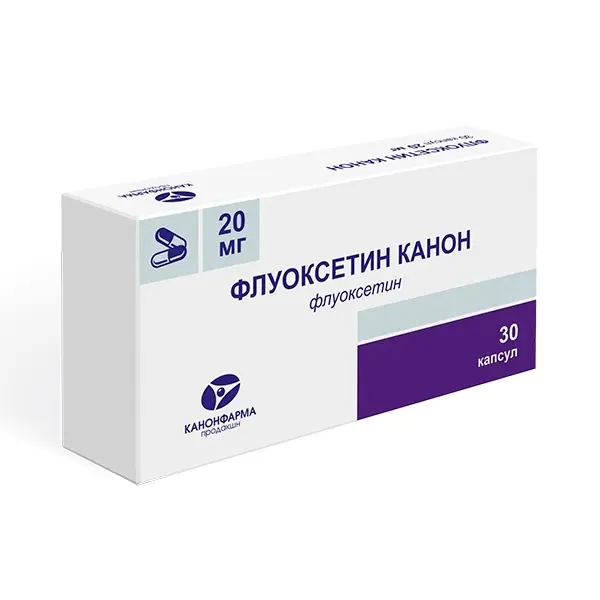Description
Fluoxetine Pharmacodynamics
Fluoxetine is an antidepressant, a selective serotonin reuptake inhibitor (SSRI), which determines its mechanism of action. Fluoxetine has little or no affinity for other receptors such as al-, a2- and P-adrenergic, serotonergic, dopaminergic, histaminergic, muscarinic and GABA receptors.
Indications
– Major depressive episodes
– Bulimia nervosa: as an adjunct to psychotherapy to reduce uncontrolled eating;
– Obsessive-compulsive disorder.
Contraindications
– Hypersensitivity to the drug and to any of the excipients;
– Children under 18 years of age;
– Concomitant use of monoamine oxidase inhibitors (MAOIs) and up to 14 days after their withdrawal. There should be at least a 5-week interval between discontinuation of fluoxetine and initiation of MAOIs. If fluoxetine is prescribed for continuous use and/or in high doses, the interval before using MAOIs should be extended;
– Concomitant administration of metoprolol used to treat heart failure.
Use in pregnancy and during breastfeeding
Pregnancy
Fluoxetine use during the first trimester of pregnancy may increase the risk of cardiovascular defects. The mechanism is unknown. Overall, evidence suggests that the risk of having a child with a cardiovascular defect after maternal exposure to fluoxetine is approximately 2/100, compared to the expected incidence of such defects in the population, approximately 1/100.
Epidemiologic evidence suggests that SSRI use during pregnancy, particularly in late pregnancy, may increase the risk of developing persistent pulmonary hypertension in newborns (approx. 5 cases per 1,000 pregnancies, whereas in the general population there are 1-2 cases of persistent pulmonary hypertension in newborns per 1,000 pregnancies).
Fluoxetine should not be administered during pregnancy unless the woman’s clinical condition warrants fluoxetine therapy and justifies the potential risk to the fetus. Abrupt discontinuation of therapy during pregnancy should be avoided. Caution should be exercised when using fluoxetine during pregnancy, especially in the late term or just before delivery, as effects such as irritability, tremor, hypotension, incessant crying, and difficulty sucking and falling asleep have been reported in newborns. These symptoms may indicate a serotonergic effect or a withdrawal syndrome. The time to onset and duration of these symptoms may be related to the long elimination half-life of fluoxetine (4-6 days) and its active metabolite, norfluoxetine (4-16 days).
Breastfeeding.
Fluoxetine and its metabolite norfluoxetine are detectable in breast milk. Adverse events have been reported in breastfed infants. If fluoxetine needs to be used, breastfeeding should be discontinued, or the possibility of taking lower doses of fluoxetine should be considered.
How to use and dosages.
- Oral.
- Fluoxetine can be taken once a day or several times a day in divided doses – during or between meals (regardless of meals).
- Major depressive episodes.
- Adult and elderly patients: The recommended daily dose is 20 mg. If necessary, the dose may be revised and adjusted within 3 to 4 weeks after initiation of therapy and thereafter, if clinically indicated. Despite a potential risk of increased incidence of adverse effects with increasing dosage, in some patients who have an insufficient response to therapy at a dose of 20 mg, the dose can be gradually increased to 60 mg (maximum dose). Dose adjustments should be made cautiously based on the needs of each individual patient – so that the patient continues to receive the minimum effective dose.
- To achieve sustained remission, the duration of therapy in depressed patients should be at least 6 months.
- Bulimia nervosa.
- Adult and elderly patients: the recommended daily dose is 60 mg. In bulimia nervosa, long-term efficacy (more than 3 months) has not been demonstrated.
- Obsessive-compulsive disorder.
- Adult and elderly patients: the recommended daily dose is 20 mg. In some patients with insufficient response at a dose of 20 mg for two weeks, the dose may be gradually increased to a maximum of 60 mg.
- If there is no improvement within 10 weeks, fluoxetine therapy should be reconsidered. If a good therapeutic response is achieved, therapy may be extended using a dose adjusted based on the individual patient’s needs. Although there are no systematic studies answering the question of the duration of fluoxetine therapy, it should be noted that obsessive-compulsive disorder (OCD) is a chronic condition, and in patients responding to therapy, it makes sense to continue treatment for more than 10 weeks. Dose adjustments should be made cautiously, based on the individual patient’s needs, so that the patient continues to receive the minimum effective dosage. The need for therapy should be reassessed periodically. For patients who have a good response to pharmacotherapy, some clinicians recommend concurrent behavioral psychotherapy. The long-term efficacy of fluoxetine (more than 24 weeks) in treating OCD has not been demonstrated.
- All indications
- The recommended dose may be reduced or increased. A systematic study of a dose greater than 80 mg/day. has not been conducted.
- Elderly Patients.
- Increasing the dose should be done with caution; in general, daily doses should not exceed 40 mg. The maximum recommended dose is 60 mg/day.
- Liver failure
- In patients with hepatic impairment, the drug is administered at a reduced dose or frequency (e.g., 20 mg every other day). These recommendations also apply to patients taking concomitant medications potentially interacting with Fluoxetine.
- Withdrawal symptoms associated with discontinuation of fluoxetine therapy Avoid abrupt discontinuation of the drug. To reduce the risk of “withdrawal syndrome”, the dose should be reduced gradually over at least one to two weeks when discontinuing Fluoxetine therapy. If intolerable symptoms develop after reducing the dose or discontinuing treatment, the drug should be resumed at the previously prescribed dose. The physician may prescribe a more gradual decrease in the dose thereafter.
- When discontinuing the drug, the active ingredient is retained in the body for several weeks. This fact should be taken into account when prescribing or terminating therapy.





